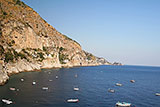Praiano
 Located between Positano and Conca dei Marini, the ancient Plagianum (from greek
"open sea") consists of a colorful and intricate maze of narrow streets,
alleys and staircases, typical houses in pastel lime with flowered balconies, terraces
of lemons and sacred images, as far as the sea. Here it is possible to enjoy one
of the most fascinating and romantic view of the Amalfi Coast: a large stretch of
sea with, on the right, the lights of the bay of Positano, Li Galli islands, the
Sorrento peninsula, the tip of Punta Campanella and the Faraglioni of Capri in the
background. Who said that the sunsets in Praiano are among the most romantic in
the world, he has told certainly the truth!
Located between Positano and Conca dei Marini, the ancient Plagianum (from greek
"open sea") consists of a colorful and intricate maze of narrow streets,
alleys and staircases, typical houses in pastel lime with flowered balconies, terraces
of lemons and sacred images, as far as the sea. Here it is possible to enjoy one
of the most fascinating and romantic view of the Amalfi Coast: a large stretch of
sea with, on the right, the lights of the bay of Positano, Li Galli islands, the
Sorrento peninsula, the tip of Punta Campanella and the Faraglioni of Capri in the
background. Who said that the sunsets in Praiano are among the most romantic in
the world, he has told certainly the truth!
Until a few years ago, Praiano was just a fishing village; today it has opened to
tourism preserving its most authentic and genuine soul, avoiding mass tourism and
offering, in this way, a quiet and relaxing atmosphere. A population of craftsmen,
since 1300-1400, the inhabitants of Praiano were specialised in the production of
linen, coral objects (artisans working with coral were easy to recognize because
of the earrings they wore, an antique Saracen tradition), hair nets, anchovies packed
in salt and weaving palms during the Easter period.
The town features numerous historical, architectural and naturalistic attractions:
- the Church of San Luca the Evangelist, in Baroque style; the interior is decorated
with a beautiful tiled floor with a floral motif and, in the center, the image of
the patron saint, depicted in the act of painting. The original structure dates
from the XIII century. Interesting are also the silver bust of the Saint (1694)
and two panel paintings ("The Circumcision" by Giovan Bernardo Lama and
the "Madonna del Rosario" by Padovano De Montorio).
- the Church of San Gennaro, in the village of Vettica Maggiore, built in Renaissance
style and features three naves and a dome covered with majolica tiles. It was built
in the XVI century on the ruins of an existing building dating from the XIII century,
which was entitled to the same Saint. Inside are preserved paintings of "The
Annunciation" (1696), "The Martyrdom of Saint Bartholomew" (1747)
by Giambattista Lama and the "Sacred Family" (end of XVI century).
- the Church of Santa Maria a Castro with the adjoining convent of San Domenico,
situated on the slopes of Mount Sant'Angelo a Tre Pizzi, at 360 meters above sea
level. It was mentioned for the first time in 1599, and preserves inside a venerated
image of Our Lady of Grace (XV century).
- the Church of San Giovanni Battista, built at the center of the town and dates
back to the XI-XII century. Inside it features a beautiful terracotta tiled floor
and a imposing pipe organ, both of the Neapolitan school.
- the Chapel of San Tommasos, a single nave plan building covered with a barrel
vault. Inside there is an XVIII century wooden crucifix and a XVI century Neapolitan
school altarpiece depicting the Madonna and Child with St. Thomas.
- the Church of St. Catherine of Alexandria, located close to the Torre a Mare;
- the Chapel of St. Nicholas, with an organ of XVIII century of the Neapolitan school,
and a famous painting depicting the saint;
- the Church of Our Lady of Constantinople;
- the remains of the Church of San Costanzo;
- numerous sacred images, built with the typical "riggiole" tiles of majolica,
which represent the fervent faith of local people;
- the fortified towers, built to defend the area from the Saracen pirate attacks,
part of the imposing defense system of the Amalfi Coast;
- Marina di Praia, a fiord bay located between two high rock walls. On the tip of
the promontory stands the Torre a Mare, of medieval origin, which is reachable by
a charming panoramic promenade around the cliff of La Praia, not far from the surface
of the sea.
- La Cala of Gavitella, the only beach on the Amalfi Coast illuminated until sunset.
On the nearby cliff stands the Tower del Grado, built during the Spanish Viceroy
domination.
By: Italia Lifestyle Locali d'Autore
- Every reproduction of texts, images or anything else here published is forbidden.
Every unauthorized reproduction does not follow italian law # 633/41.